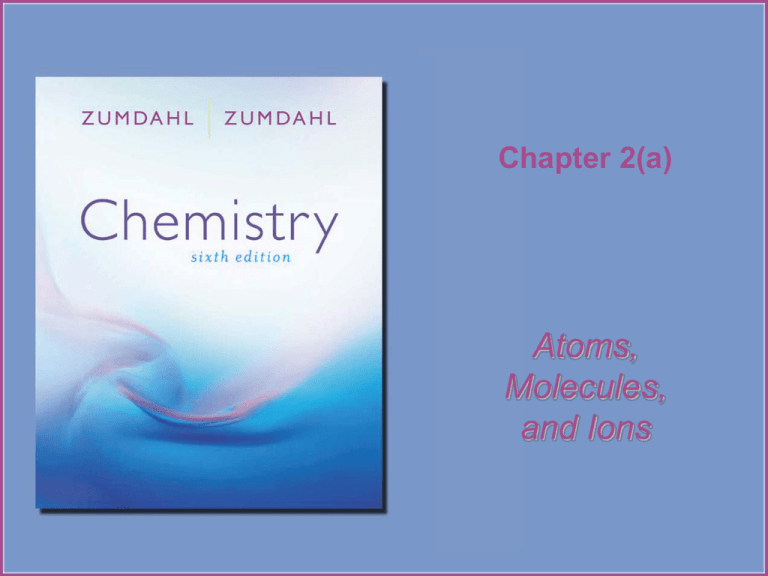
Chapter 2(a)
Atoms,
Molecules,
and Ions
Figure 2.7: A cathode-ray tube. The fastmoving electrons excite the gas in the tube,
causing a glow between the electrodes.
Copyright © Houghton Mifflin Company. All rights reserved.
2a–2
Figure 2.8: Deflection of cathode rays by an
applied electric field.
Copyright © Houghton Mifflin Company. All rights reserved.
2a–3
Figure 2.9: The plum pudding model of the
atom.
Copyright © Houghton Mifflin Company. All rights reserved.
2a–4
Figure 2.10: A schematic representation of
the apparatus Millikan used to determine the
charge on the electron.
Copyright © Houghton Mifflin Company. All rights reserved.
2a–5
Rutherford
Copyright © Houghton Mifflin Company. All rights reserved.
2a–6
Figure 2.12: Rutherford's experiment on
-particle bombardment of metal foil.
Copyright © Houghton Mifflin Company. All rights reserved.
2a–7
Figure 2.13: (a) The expected results of the
metal foil experiment if Thomson's model
were correct. (b)Actual results.
Copyright © Houghton Mifflin Company. All rights reserved.
2a–8
Figure 2.14:
A nuclear
atom viewed
in cross
section. Note
that this
drawing is
not to scale.
So how many nucleons (protons or neutrons) in 1 gram?
1 / 1.67 x 10-24
= 6.022 x 1023
Copyright © Houghton Mifflin Company. All rights reserved.
= Avogadro’s number = N
2a–10
The molar mass of water is 18 g/mol.
How many water molecules are present
in 18 cc of water?
How much does 1 mole of water weigh?
How many hydrogen atoms are present
In 9 grams of water?
Copyright © Houghton Mifflin Company. All rights reserved.
2a–11
Nitrogen (N2) and hydrogen (H2) react
to form ammonia (NH3):
N2 + H2 NH3
N2 + 3H2 2NH3
How much hydrogen is need to completely react with
7 grams of nitrogen?
How much ammonia will that produce?
With 7 gram each of nitrogen and hydrogen,
Which is the limiting reagent?
Copyright © Houghton Mifflin Company. All rights reserved.
2a–12
Figure 2.15: Two isotopes of sodium. Both
have eleven protons and eleven electrons,
but they differ in the number of neutrons in
their nuclei.
Copyright © Houghton Mifflin Company. All rights reserved.
2a–13
Figure 2.21: The Periodic Table.
Copyright © Houghton Mifflin Company. All rights reserved.
2a–14
Copyright © Houghton Mifflin Company. All rights reserved.
2a–15
Copyright © Houghton Mifflin Company. All rights reserved.
2a–16
Copyright © Houghton Mifflin Company. All rights reserved.
2a–17
Crystals of copper(II) sulfate.
Copyright © Houghton Mifflin Company. All rights reserved.
2a–18
Various chromium compounds dissolved in water.
From left to right; CrCl2, K2Cr2O7, Cr(NO3)3, CrCl3,
K2CrO4.
Copyright © Houghton Mifflin Company. All rights reserved.
2a–19
Figure 2.22: The common cations and
anions
Copyright © Houghton Mifflin Company. All rights reserved.
2a–20
Copyright © Houghton Mifflin Company. All rights reserved.
2a–21
Copyright © Houghton Mifflin Company. All rights reserved.
2a–22
Figure 2.23: A flowchart for naming binary
compounds.
Copyright © Houghton Mifflin Company. All rights reserved.
2a–23
Figure 2.24: Overall strategy for naming
chemical compounds.
Copyright © Houghton Mifflin Company. All rights reserved.
2a–24
Copyright © Houghton Mifflin Company. All rights reserved.
2a–25
Copyright © Houghton Mifflin Company. All rights reserved.
2a–26
Figure 2.25: A flowchart for naming acids.
An acid is best considered as one or more
H+ ions attached to an anion.
Copyright © Houghton Mifflin Company. All rights reserved.
2a–27
Copyright © Houghton Mifflin Company. All rights reserved.
2a–28
Copyright © Houghton Mifflin Company. All rights reserved.
2a–29
Figure 2.4: A representation of some of
Gay-Lussac's experimental results on
combining gas volumes.
Copyright © Houghton Mifflin Company. All rights reserved.
2a–30
Figure 2.5: A representation of combining
gases at the molecular level. The spheres
represent atoms in the molecules.
Copyright © Houghton Mifflin Company. All rights reserved.
2a–31
The molar mass of styrene is 104.14 g/mol.
How many styrene molecules are present
in 104.14 gram of styrene?
The empirical formula of styrene is CH;
How many H atoms are present
in a 52.07 g sample of styrene?
what is the molecular formula of styrene?
Copyright © Houghton Mifflin Company. All rights reserved.
2a–32
Figure 2.16:
The
structural
formula for
methane.
Figure 2.17: Space-filling model of methane. This
type of model shows both the relative sizes of the
atoms in the molecule and their spatial
relationships.
Copyright © Houghton Mifflin Company. All rights reserved.
2a–34
Figure 2.18: Ball-and-stick model of
methane.
Copyright © Houghton Mifflin Company. All rights reserved.
2a–35
Figure 2.19: Sodium metal reacts with
chlorine gas to form solid sodium chloride.
Figure 2.20: Ball-and-stick models of the
ammonium ion and the nitrate ion.
Copyright © Houghton Mifflin Company. All rights reserved.
2a–37
Figure 1.13: The three states of water (where red
spheres represent oxygen atoms and blue spheres
represent hydrogen atoms).
Copyright © Houghton Mifflin
Company. All rights reserved.
1b–38
Figure 1.14: Simple laboratory distillation
apparatus.
Copyright © Houghton Mifflin
Company. All rights reserved.
1b–39
Figure 1.16: The organization of matter.
Copyright © Houghton Mifflin
Company. All rights reserved.
1b–40

